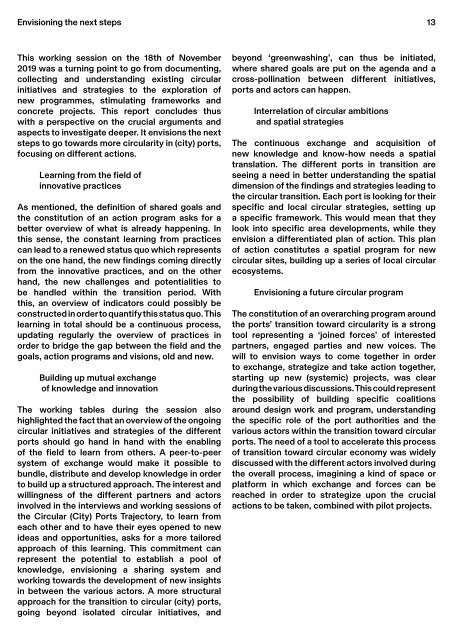CIrcular (City)Ports_ report WS4_
- No tags were found...
Create successful ePaper yourself
Turn your PDF publications into a flip-book with our unique Google optimized e-Paper software.
Envisioning the next steps<br />
13<br />
This working session on the 18th of November<br />
2019 was a turning point to go from documenting,<br />
collecting and understanding existing circular<br />
initiatives and strategies to the exploration of<br />
new programmes, stimulating frameworks and<br />
concrete projects. This <strong>report</strong> concludes thus<br />
with a perspective on the crucial arguments and<br />
aspects to investigate deeper. It envisions the next<br />
steps to go towards more circularity in (city) ports,<br />
focusing on different actions.<br />
Learning from the field of<br />
innovative practices<br />
As mentioned, the definition of shared goals and<br />
the constitution of an action program asks for a<br />
better overview of what is already happening. In<br />
this sense, the constant learning from practices<br />
can lead to a renewed status quo which represents<br />
on the one hand, the new findings coming directly<br />
from the innovative practices, and on the other<br />
hand, the new challenges and potentialities to<br />
be handled within the transition period. With<br />
this, an overview of indicators could possibly be<br />
constructed in order to quantify this status quo. This<br />
learning in total should be a continuous process,<br />
updating regularly the overview of practices in<br />
order to bridge the gap between the field and the<br />
goals, action programs and visions, old and new.<br />
Building up mutual exchange<br />
of knowledge and innovation<br />
The working tables during the session also<br />
highlighted the fact that an overview of the ongoing<br />
circular initiatives and strategies of the different<br />
ports should go hand in hand with the enabling<br />
of the field to learn from others. A peer-to-peer<br />
system of exchange would make it possible to<br />
bundle, distribute and develop knowledge in order<br />
to build up a structured approach. The interest and<br />
willingness of the different partners and actors<br />
involved in the interviews and working sessions of<br />
the Circular (<strong>City</strong>) <strong>Ports</strong> Trajectory, to learn from<br />
each other and to have their eyes opened to new<br />
ideas and opportunities, asks for a more tailored<br />
approach of this learning. This commitment can<br />
represent the potential to establish a pool of<br />
knowledge, envisioning a sharing system and<br />
working towards the development of new insights<br />
in between the various actors. A more structural<br />
approach for the transition to circular (city) ports,<br />
going beyond isolated circular initiatives, and<br />
beyond ‘greenwashing’, can thus be initiated,<br />
where shared goals are put on the agenda and a<br />
cross-pollination between different initiatives,<br />
ports and actors can happen.<br />
Interrelation of circular ambitions<br />
and spatial strategies<br />
The continuous exchange and acquisition of<br />
new knowledge and know-how needs a spatial<br />
translation. The different ports in transition are<br />
seeing a need in better understanding the spatial<br />
dimension of the findings and strategies leading to<br />
the circular transition. Each port is looking for their<br />
specific and local circular strategies, setting up<br />
a specific framework. This would mean that they<br />
look into specific area developments, while they<br />
envision a differentiated plan of action. This plan<br />
of action constitutes a spatial program for new<br />
circular sites, building up a series of local circular<br />
ecosystems.<br />
Envisioning a future circular program<br />
The constitution of an overarching program around<br />
the ports’ transition toward circularity is a strong<br />
tool representing a ‘joined forces’ of interested<br />
partners, engaged parties and new voices. The<br />
will to envision ways to come together in order<br />
to exchange, strategize and take action together,<br />
starting up new (systemic) projects, was clear<br />
during the various discussions. This could represent<br />
the possibility of building specific coalitions<br />
around design work and program, understanding<br />
the specific role of the port authorities and the<br />
various actors within the transition toward circular<br />
ports. The need of a tool to accelerate this process<br />
of transition toward circular economy was widely<br />
discussed with the different actors involved during<br />
the overall process, imagining a kind of space or<br />
platform in which exchange and forces can be<br />
reached in order to strategize upon the crucial<br />
actions to be taken, combined with pilot projects.


















